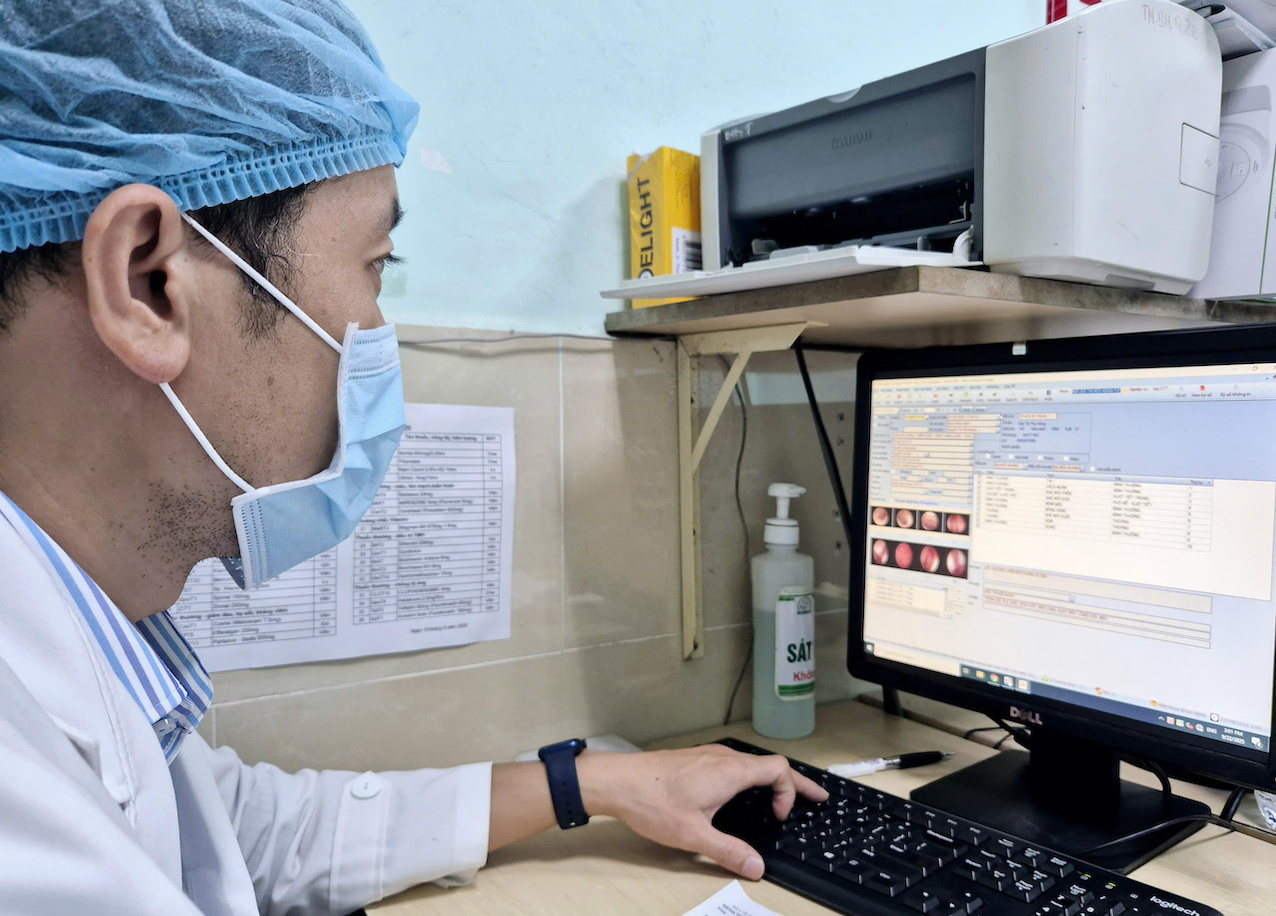At the Ho Chi Minh City Ear, Nose, and Throat Hospital on the morning of 23/9, Dr. Ly Quang Khai completed a patient's admission form electronically in just a few minutes. Previously, he and the nurses would spend considerable time manually filling out repetitive information like name, date of birth, address, health insurance number, medical history, and diagnosis on numerous paper forms. This administrative data had to be rewritten daily for each day a patient was hospitalized.
"Now, we only need to enter patient information once, and the system automatically synchronizes it. Doctors have more time for specialized tasks, and colleagues in other departments can easily access the information when needed for consultations," Dr. Khai explained.
 |
Dr. Khai reviews and creates patient medical records electronically. Photo: Le Phuong |
Dr. Khai reviews and creates patient medical records electronically. Photo: Le Phuong
The electronic medical record system officially went live hospital-wide after three months of trials in selected departments and two weeks of hospital-wide testing. From the emergency room and operating rooms to patient wards, hundreds of doctors, nurses, and other medical staff now input, transfer, and access information on computers and iPads instead of paper files.
According to Dr. Khuu Minh Thai, Deputy Director of the hospital, this journey has spanned over a year with multiple testing and adjustment phases. The initial challenge was overcoming ingrained habits. However, with the system now stable, the benefits are clear. All data, from administrative details and lab results to diagnostic imaging and treatment information, is interconnected, eliminating redundant record-keeping for doctors.
Returning patients no longer need to bring physical documents. They can access their entire treatment history, prescriptions, and past procedures. Doctor's orders are also instantly transmitted to computers, eliminating the need for nurses to decipher handwriting or wait for physical transfer. This significantly reduces the risk of errors and shortens treatment times. A 2022 study in Health Affairs journal found that electronic health records can reduce doctors' administrative time by 35% and increase patient care efficiency by 15-20%.
Dr. Le Tran Quang Minh, Director of the Ho Chi Minh City Ear, Nose, and Throat Hospital, stated that the electronic medical record data also facilitates interdepartmental synchronization, supports real-time reporting, and provides instant statistics. "The hospital is ensuring daily medical examination and treatment activities while urgently adjusting the software for increasingly seamless operation, moving towards a smart hospital model," he said.
This scenario is common in many Ho Chi Minh City hospitals in the final days of September. Major hospitals such as Nhan Dan 115, Nhi Dong 2, and Da Lieu TP HCM are all transitioning from paper to digital systems. Thousands of medical staff are adapting to the new software, balancing their treatment duties with the race to meet the Ministry of Health's September 30 deadline for eliminating paper medical records. As of early September, approximately 500 out of over 1,800 hospitals nationwide have transitioned to electronic medical records.
Dr. Pham Ngoc Thach, Deputy Director of Nhi Dong 2 Hospital, said the hospital began trial operations in early September. On 17/9, the hospital board assessed the implementation and agreed that the hospital met the conditions for official deployment, leading to the complete replacement of paper records. The hospital has submitted the meeting minutes and documentation to the Ministry of Health, awaiting official announcement on the ministry’s portal.
At Nhan Dan Gia Dinh Hospital, the electronic medical record system, already approved by the Ministry of Health, has been operating hospital-wide since the beginning of the year. According to Dr. Huynh Van Binh, Head of Planning and Synthesis, the implementation has brought many positive changes. Patient records are centrally stored, easily accessible when transferring between departments or during return visits. Statistics, reporting, and specialized planning are also more accurate. This forms the basis for Big Data, paving the way for artificial intelligence applications in healthcare. Electronic records are now linked with personal health records and management agencies, while ensuring strict data security and privacy.
 |
A patient views their electronic health record on their phone at Nhan Dan Gia Dinh Hospital. Photo: Hanh Hoang |
A patient views their electronic health record on their phone at Nhan Dan Gia Dinh Hospital. Photo: Hanh Hoang
However, according to hospitals, for the system to reach its full potential, the Ministry of Health needs to further improve the legal framework, prioritize technology infrastructure investment for major hospitals, and promote national medical data interoperability.
Le Phuong












